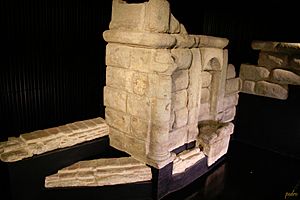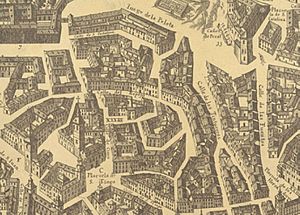Fountain of the Pear Tree Canals facts for kids
The Fountain of the Pear Tree Canals (also called Spanish: Fuente de los Caños del Peral in Spanish) is a very old fountain. It was found buried deep under a square called Plaza de Isabel II in Madrid, Spain, in 2009. People think its name came from a pear tree that grew there in the 1200s. This tree shaded the natural spring that fed the fountain. Sometimes, it was also known as the Spanish: Lavadero de los Caños del Peral, which means "Laundry of the Pear Tree Canals."
Contents
The Fountain's Amazing Story
How Old Is It?
This fountain was first written about in the 1400s. Back then, it was known by names like Hontanillas or Fontanillas. Some people believe it might have been one of the first public baths in Madrid.
What Was It Used For?
The water from these canals was very important for the people of Madrid. It was carried around the city by water carriers. The water was also used by "lavadores," who were people who washed clothes. The part of the fountain that was found was built in the 1600s. It was about 34 meters (111 feet) long. It sat in a small valley at the end of Arenal Street. The fountain was made from large, smooth granite stones.
Sharing Water with Royalty
The fountain shared its spring water with the Royal Palace of Madrid until the mid-1700s. The water traveled to the palace through a special water channel called the Amaniel Aqueduct. The fountain continued to be used until it was buried in 1809. It was buried about 8 meters (26 feet) deep, along with its spring. This was done to make space for new buildings like the Teatro Real (a famous opera house), the Plaza de Oriente, and the Plaza de Isabel II.
Rediscovery and Museum
In 2009, workers began to fix up the Ópera Metro station. This station serves the Teatro Real and the two plazas. During this work, they found the buried fountain! After two years of careful restoration, the upgraded station opened in 2011.
Now, the station includes an amazing archaeological museum. You can see parts of the fountain there. Other old items found at the site are also on display. These include pieces of the old Arenal Sewer and the royal Amaniel Aqueduct. The museum is about 200 square meters (2,150 square feet) in size. It is free to visit if you have a metro ticket. Madrid is known for having many hidden water sources beneath its streets.
To remember this important discovery, a small copy of the fountains was built in the Plaza Isabel.
Gallery
See also
 In Spanish: Fuente de los Caños del Peral para niños
In Spanish: Fuente de los Caños del Peral para niños








